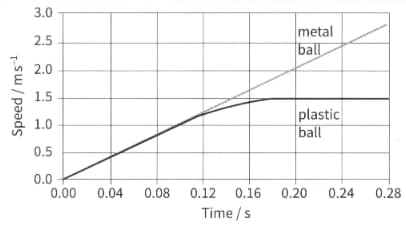These are the speed-time graphs for two falling balls:

Explain why both balls have the same initial acceleration.


Important Questions on Dynamics: Explaining Motion
A car of mass accelerates from rest to a speed of in a time of . Calculate the forward driving force acting on the car while it is accelerating. Assume that, at low speeds, all frictional forces are negligible.
A car of mass accelerates from rest to a speed of in a time of . At high speeds the resistive frictional force produced by air on a body moving with velocity is given by the equation , where is a constant. Derive the base units of force in the SI system.
A car of mass accelerates from rest to a speed of in a time of .
(b) At high speeds the resistive frictional force produced by air on a body moving with velocity is given by the equation , where is a constant.
(ii) Determine the base units of in the SI system.
A car of mass accelerates from rest to a speed of in a time of . At high speeds the resistive frictional force produced by air on a body moving with velocity is given by the equation , where is a constant. The car continues with the same forward driving force and accelerates until it reaches a top speed of . At this speed the resistive force is given by the equation . Determine the value of for the car.
A car of mass accelerates from rest to a speed of in a time of . At high speeds the resistive frictional force produced by air on a body moving with velocity is given by the equation , where is a constant. Use your value of and the driving force to calculate the acceleration of the car when the speed is .
A car of mass accelerates from rest to a speed of in a time of . At high speeds the resistive frictional force produced by air on a body moving with velocity is given by the equation , where is a constant. Sketch a graph showing how the value of varies with over the range to . Use your graph to describe what happens to the acceleration of the car during this time.
Explain what is meant by the mass of a body and the weight of a body.
State and explain one situation in which the weight of a body changes while its mass remains constant.
